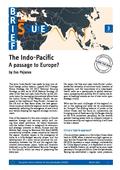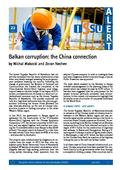You are here
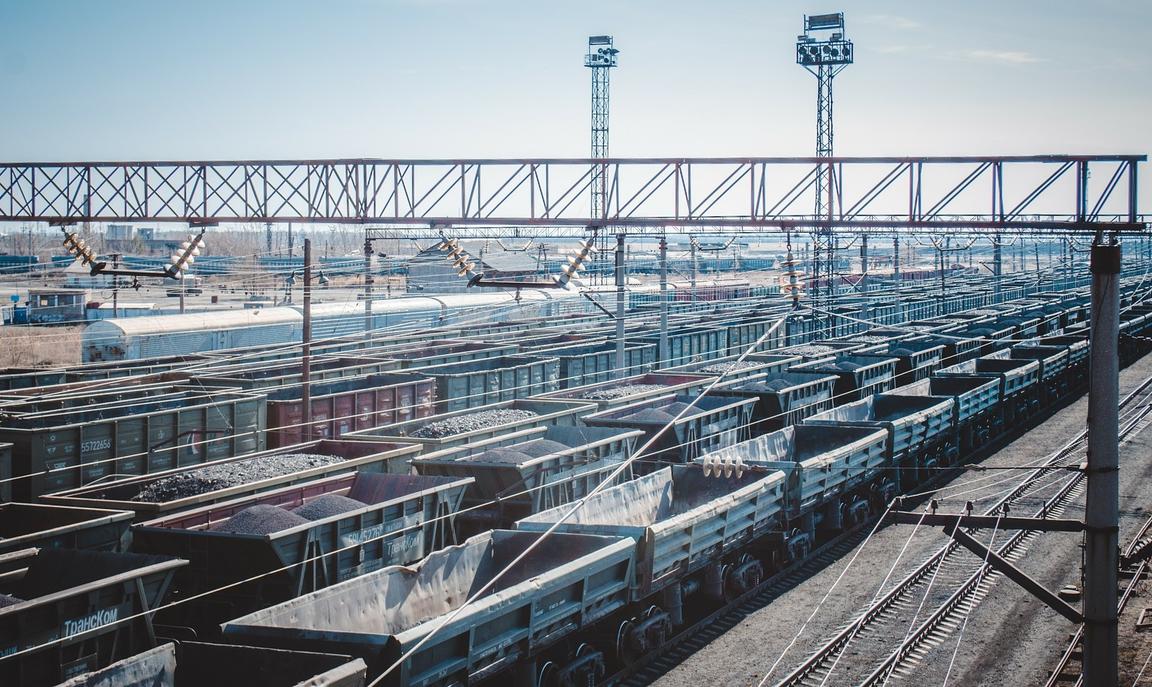
Connecting the dots: challenges to EU connectivity in Central Asia
Introduction
Despite ‘connectivity’ having become a new global buzzword, an exact definition of the term remains elusive. If various EU descriptions are combined, connectivity comprises of transport, digital, energy and human networks, as well as rules, standards and institutions which govern the flows of interaction. Moreover, the EU’s September 2018 Connectivity Strategy defines the European interpretation of connectivity as sustainable, comprehensive and rules-based.1
This European vision of connectivity also runs through the EU’s new Central Asia Strategy, which was adopted on 15 May 2019. Compared with the previous Central Asia Strategy from 2007, the new Strategy places increased emphasis on encouraging economic development (‘prosperity’), comprehensive security (‘resilience’) and intra-regional cooperation between the Central Asian states: Kazakhstan, Kyrgyzstan, Tajikistan, Turkmenistan and Uzbekistan.2 In order for prosperity and resilience to be achieved, significant regional connectivity challenges – which largely stem from the legacy of the region’s Soviet past (including its dramatic rupture and the informal shadow networks that quickly took root) – need to be overcome. Furthermore, the EU’s Strategy faces competing visions of connectivity from both China and Russia.
This Brief looks into connectivity-related challenges and how they relate to the EU’s new Central Asia Strategy and its vision of connectivity. This means examining the legacy of Soviet connectivity, the significance of regional informal networks, as well as the impact of China’s Belt and Road Initiative (BRI) and Russia’s Great Eurasian Partnership.
The Soviet connectivity legacy
Perhaps the most important feature of Central Asian connectivity today is its Soviet legacy. Over 70 years of Soviet rule shaped Central Asia dramatically and its impact can still be felt: even the borders of the current Central Asian states were drawn in Moscow in the 1920s (although they were of little significance in the Moscow-centred, hierarchical structure of the Soviet Union).3 One uniform political, social and economic system covered all ten time zones of the Soviet Union, and with the country’s external borders effectively closed to the outside world, connectivity ended at the borders of Central Asia. This explains why the infrastructure connecting the region to the wider world – as well as the Central Asian states to one another – was largely missing in the early post-Soviet years (see Figure 1).
Figure 1: Infrastructure in Central Asia – Soviet and post-Soviet railways and pipelines
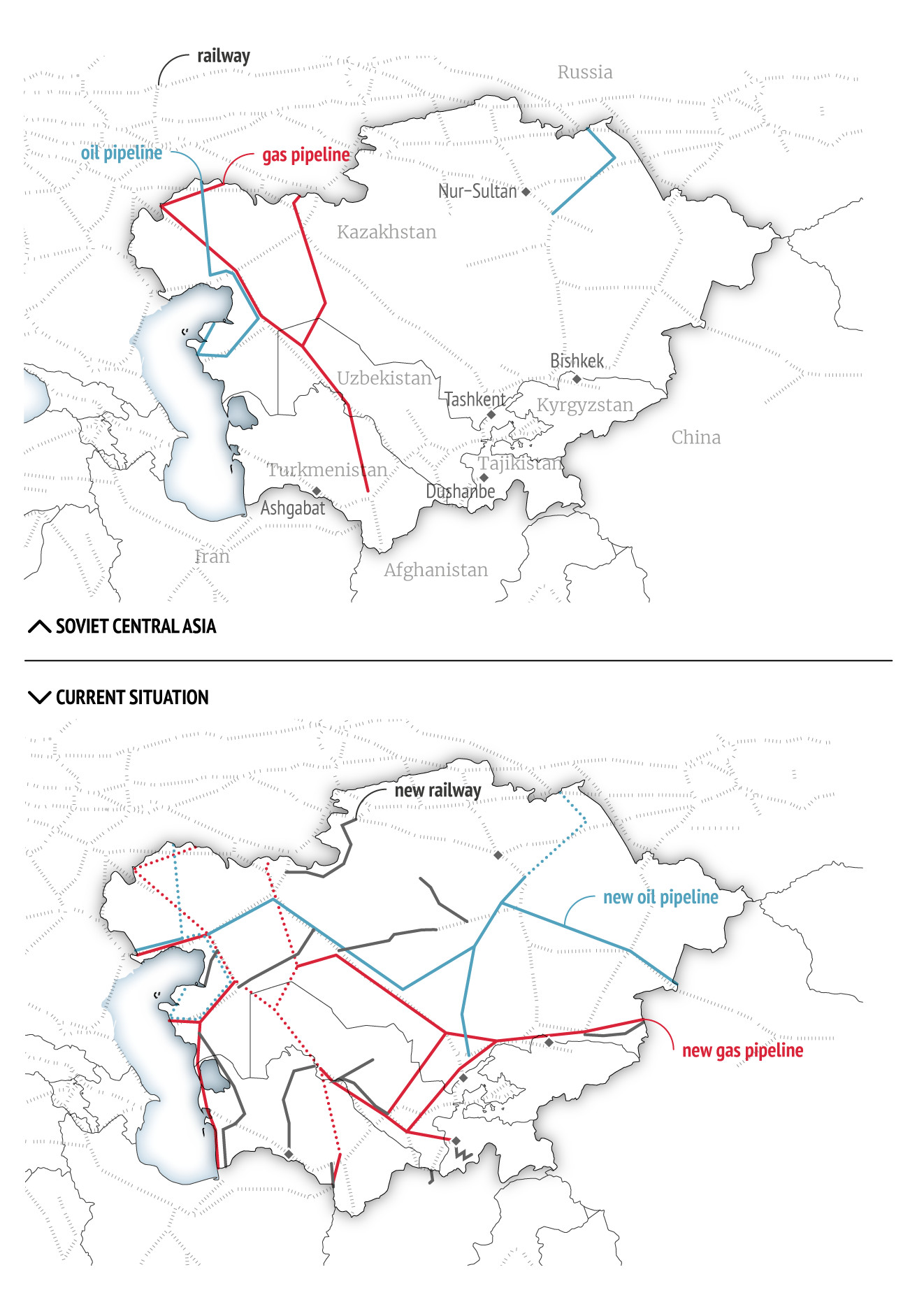
Data: Natural Earth, 2019; GUGK SSSR, 1991; KazTransGaz, 2019; KazTransOil, 2019; Library of Congress, 1989; Openrailwaymap.org, 2019
The planned economic system and administrative divisions organised the space vertically rather than horizontally, with grand industrialisation schemes and resettlement programmes often adversely affecting local people.4 That said, Soviet connectivity also had advantages: populations were generally universally literate and had access to education and basic healthcare, even in remote regions. Underdeveloped regions like Central Asia also benefitted from significant federal subsidies, something which in part explains the somewhat hesitant attitude towards independence in the 1990s.
When the all-Soviet space ceased to exist, the Central Asian republics suffered from an almost complete loss of infrastructure networks and with them the associated flows of interaction. The foundations of their economies were suddenly undermined, which led to the partial deindustrialisation of the region,5 while the remaining infrastructure reflected political realities of a bygone era. This also contributed to political tensions between the states: with Moscow no longer deciding on shares and quotas, the control over shared resources quickly became weapons in the struggle for regime survival and regional competition. Over the past 28 years, quarrels between down- and upstream states over water distribution, the cutting off of energy and gas deliveries and the closing of borders and vital transport routes have been commonplace in Central Asia. One particularly volatile region is the densely populated Fergana valley, which spans Uzbekistan, Tajikistan and Kyrgyzstan (see Figure 2). Tension and cross-border incidents are common in the eight ethnic enclaves in different parts of Fergana Valley:6 in 2010, some 470 persons died, 1,900 were injured, and thousands were displaced in the Kyrgyz part of the valley in Osh.7 The latest incident occurred in March 2019, when two Tajik men were killed and several wounded in the Batken region in Kyrgyzstan.8
Figure 2: Fergana Valley – Including ethnic enclaves
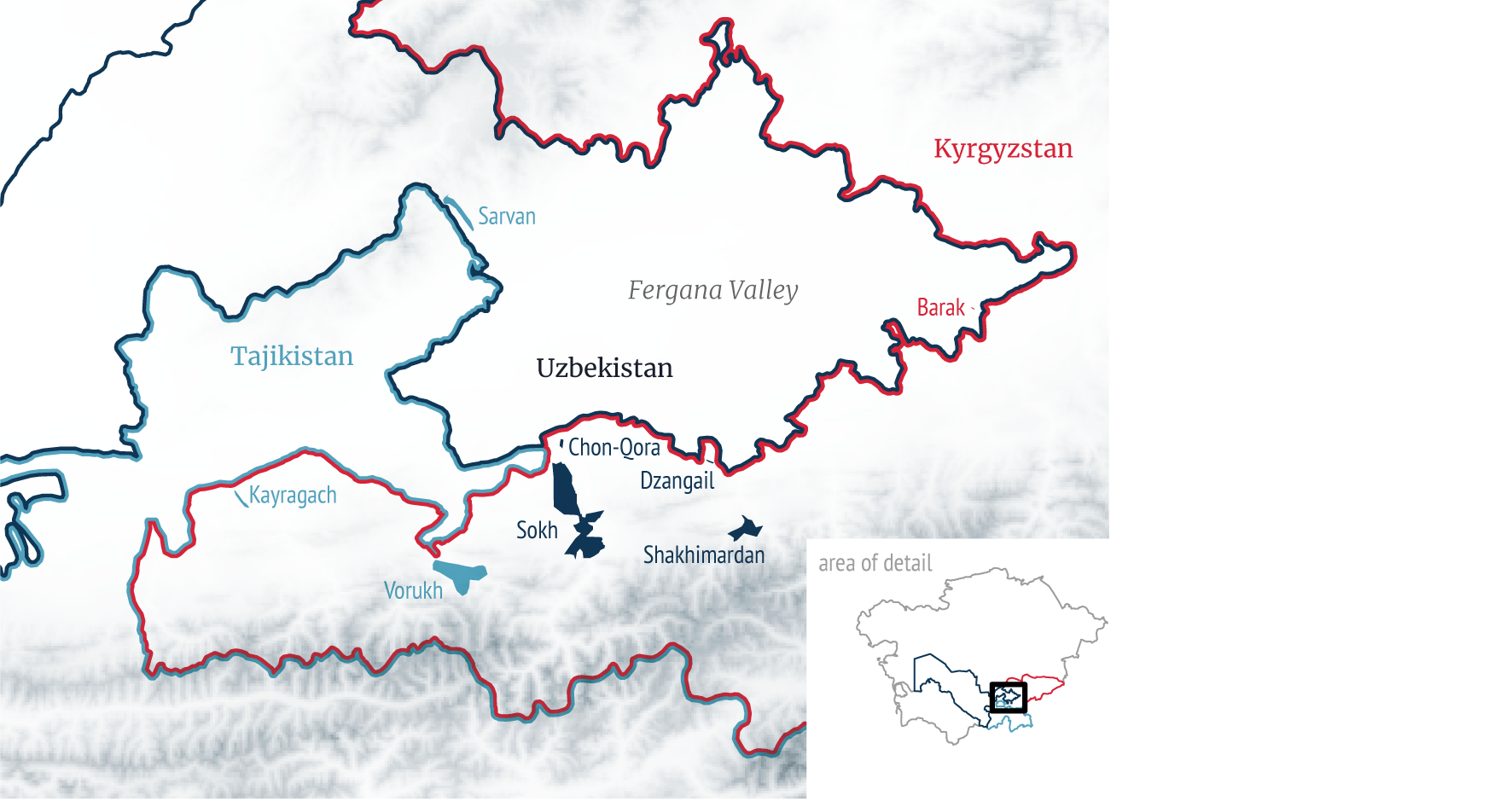
Data: GADM, 2019; UN Office for the Coordination of Humanitarian Affairs; 2013. The boundaries and names shown and the designations used do not imply official endorsement or acceptance by the EUISS.
Distrust between the Central Asian republics has often reached critical levels: in 2000, Uzbekistan planted landmines along its borders with Tajikistan and Kyrgyzstan out of fear that militant Islamists were entering its territory, for instance. Tashkent did not provide adequate information to its neighbours and over the years the mines have caused dozens of deaths and hundreds of serious injuries. Only after 2016 following the death of Islam Karimov, Uzbekistan’s long-time authoritarian leader, have things started to change. Last year, Uzbekistan and Tajikistan abolished visa requirements between them (that had been in place for 17 years), reopened a railway link and established a flight connection between Tashkent and Dushanbe.9 In addition, Tajikistan ended a nine-year ban on electricity delivery to Uzbekistan and the latter ended a six-year suspension of gas deliveries to Tajikistan.10 The countries have also agreed to demine the border zone between them.11
In March 2018, the leaders of Central Asian republics met for the first time in nine years.12 The leaders agreed to establish regular consultations in several formats and at different levels – some of which have materialised and some of which have not. While the meeting was in itself a significant demonstration of regional thaw, the process is indeterminate: for instance, the Tashkent summit scheduled for 12 April 2019 was postponed to an unspecified date, allegedly due to a disagreement over the agenda. In sum, the region has only recently taken steps to alleviate the effects of vertical Soviet connectivity and it still suffers from a distinct lack of political and economic integration. It is precisely these shortcomings which the EU’s own strategy seeks to address.
Central Asia’s shadow connections
While the region has been disconnected at the highest diplomatic levels, it also displays other features of negative connectivity. Due to the rigid, centrally-planned Soviet economy in which consumer demand and supply chains rarely proved adequate, informal networks became an important way for Soviet citizens to get by.13 These networks gained a new character and level of importance under the conditions of newly-gained independence, which was characterised by state weakness and dysfunctional economies. Privatisation and more porous borders created new opportunities for these informal networks, which subsequently became interwoven with state structures.
During the 1990s, state authority in Central Asia was in practice often consolidated with the help of these informal, clientelistic networks.14 Although the dynamics and degree varied from country to country, informal ‘shadow’ networks play a significant role at multiple levels in all of the Central Asian states.15 The shadow networks support – or in some cases are a fundamental part of – authoritarian regimes in the region. Even in Kyrgyzstan, where power has been transferred through competitive elections, new leaders quickly engaged in similar informal rent-distribution practices using their own patron-client networks.16
These corrupt vested interests have negatively affected economic transparency and regional economic development over the past 28 years. While Central Asian actors are fully integrated into the global economy when it comes to hiding illegal assets abroad, there traditionally has been only limited interest in more legitimate forms of global economic norms and practices in the region.17 Yet in the past five years, this appears to have changed: Tajikistan joined the World Trade Organisation (WTO) in 2013 and Kazakhstan did so in 2015, while Uzbekistan is aiming to join in the near future (Kyrgyzstan has been in the WTO since 1998 and Turkmenistan has no plans to join).
Furthermore, corruption enables and supports organised crime such as trafficking networks, which play a significant role in the region. Central Asia is a key route through which Afghan opiates are trafficked: around 30 percent of the heroin manufactured in Afghanistan is estimated to be smuggled through the region.18 There is evidence of cooperation between drug traffickers and local authorities in Central Asia, particularly along the infamous ‘northern route’ of the Afghan opioids trade which runs through Tajikistan, Kyrgyzstan and Kazakhstan.19 Some links between extremism and organised crime also appear to exist, in particular between drug trafficking and funding of terrorism.20 However, a recently published in-depth study of the phenomenon argues that while criminal and terrorist groups coexist in the same areas Central Asia, very rarely do they actually converge.21
Radicalisation and terrorism are major concerns for a region which shares a 2,000 km border with war-torn Afghanistan. In comparison to international levels, the level of terrorist violence in Central Asia is – at least for the time being – relatively low: between 2008-2018 there were 18 fatal acts of terrorism in Central Asia which claimed the lives of a total of 142 people. That said, many Central Asian citizens have joined radical Islamist movements in Afghanistan, Iraq and Syria: it has been estimated that some 2,000-4,000 people from the region had joined Daesh in Iraq and Syria since 2012. The most high-profile case was the defection of the head of Tajikistan’s paramilitary police, Gulmurod Khalimov, to Daesh in 2015 and his subsequent rise to the post of ‘minister of war’ before his death in 2017. It is unclear how many fighters have returned or will return to Central Asia – estimates of the number of Central Asian Daesh fighters who are still alive vary from 850 to 3,000.22
Estimates of the number of Central Asian Daesh fighters who are still alive vary from 850 to 3,000
These different types of shadow connections have negatively impacted regional development in significant ways. The far-reaching and entrenched corrupt networks have hindered sustainable economic development, supported criminal and terrorist networks and damaged confidence-building initiatives between and inside the Central Asian states. It is difficult to address these problems as state actors are often part of the problem. Partly due to this fact, the EU is attempting to strengthen its engagement with non-state actors in Central Asia. It is understood, however, that there are no short cuts to economic success: the region has significant growth potential but to attract more European investors, human rights, the rule of law and transparency need to be strengthened.
China’s connectivity priorities
Despite its significant problems, Central Asia remains a key region connecting Europe and East Asia and many external actors have demonstrated an increased interest in developing ties with Central Asian states (see text box below). One of the key promoters of enhanced connectivity in Central Asia is China – but Beijing’s vision of connectivity differs significantly from that of Europe.
Regional policy initiatives of external actors
| CHINA Belt Road Initiative ›› Economic development ›› Connectivity, infrastructure ›› Soft power, cultural cooperation |
EUROPEAN UNION EU Central Asia Strategy ›› Economic development ›› Comprehensive security ›› Regional cooperation ›› Connectivity, infrastructure |
| INDIA Connect Central Asia ›› Connectivity, infrastructure ›› Political and security cooperation ›› Soft power, cultural cooperation |
JAPAN Central Asia plus Japan Dialogue ›› Economic development ›› Regional cooperation ›› Comprehensive security |
| RUSSIA Greater Eurasia Partnership ›› Security cooperation, counter-terrorism ›› Economic development |
SOUTH KOREA Eurasia Initiative ›› Energy infrastructure and connectivity ›› Economic development ›› Soft power, cultural cooperation |
| TURKEY Middle Corridor ›› Connectivity, infrastructure ›› Economic development |
UNITED STATES C5+1 ›› Security cooperation, counter-terrorism ›› Economic development ›› Connectivity, infrastructure |
Central Asia is a vitally important region for China’s Belt Road Initiative (BRI). In fact, President Xi first introduced the framework in a speech at the Nazarbayev University in Kazakhstan in September 2013. For China, Central Asia is an important source of raw materials, particularly hydrocarbons, as well as a gateway to European markets. The economic development and political stability in Central Asia also has a direct impact on China’s internal security, particularly with regard to the Muslim-majority Xinjiang province. Through the BRI, China is addressing and attempting to solve some of the connectivity problems in Central Asia – such as the weak infrastructure framework and lack of investment – while paying less attention to (or even ignoring) other concerns such as environmental degradation.
China attempts to set the terms of engagement through proactivity and scale, rather than by excluding other actors.23 According to the official BRI online portal, the initiative comprises extensive bilateral political cooperation (‘policy coordination’), large-scale infrastructure projects (‘facilities connectivity’), trade agreements (‘unimpeded trade’), enhancing financial cooperation (‘financial integration’), as well as cultural cooperation and increasing people-to-people contacts (‘people-to-people bonds’).24 As elsewhere, China’s influence in Central Asia derives from a wave of investment and lending for infrastructure, sharing its regulatory standards and engaging with variety of actors on different levels in research, the media, finance and policymaking.25 The political goals are often more important than short-term cost-benefit calculations: economic corridors, networks, cables, terminals and satellites are often considered worthwhile strategic investments even if they do not necessarily yield profit for many years to come.26
So far, the results of China’s BRI in Central Asia have been mixed. Over the past ten years, China has become a significant regional player and is now the second-biggest trading partner in the region after the EU. Through the BRI, China has invested billions of dollars to develop regional transport infrastructure and manufacturing facilities. These projects include a freight railway linking the Chinese port of Lianyungang with Almaty and plans for further corridors between southern China and Central Asia. Beijing is also set to turn the Kazakh city of Khorgos into a logistics hub handling trans-Eurasian cargo trains travelling from China to Europe. However, despite significant growth in relative terms – the volume of trans-Eurasian rail cargo rose from 25,000 freight containers in 2014 to 145,000 containers in 2016 – its market share only makes up around 1% of the total trade between Asia and Europe; more than 90% of Asia-Europe freight continues to be shipped.27
Although estimates about the exact figures of BRI spending vary greatly,28 the inflow of tens of billions of euros of infrastructure spending from China has prompted concerns about possible increases in corruption and the strengthening of informal patronal networks in Central Asia.29 In Kyrgyzstan, embezzlement by the authorities through the overpricing of infrastructure costs for a BRI project in collaboration with a Chinese contractor led to investigations and arrests in 2018, for instance.30 A lack of transparency and adequate oversight of projects may lead to the launch of inefficient or even unviable projects – and will, in turn, negatively impact the ability of Central Asian states to pay back the loans. The latter is a particular danger for the region’s poorest and most heavily indebted countries, Tajikistan and Kyrgyzstan.31
A lack of transparency and adequate oversight of projects may lead to the launch of inefficient or even unviable projects – and will, in turn, negatively impact the ability of Central Asian states to pay back the loans.
In contrast to the EU’s approach, environmental and climate-related issues are secondary concerns for Chinese connectivity projects in Central Asia. For instance, Tajikistan has tried to reduce regional connectivity rivalries with Uzbekistan by building new coal operated power plants with the help of China. Although these projects allow Tajikistan to overcome electricity shortages in the short term, they disregard climate and environmental aspects: the new plants consume 45% of the coal produced in the country and have led to a dramatic increase in mining.32 This is just one example of a climate insensitive approach that, according to an expert report, increases the risk of social instability and conflict potential in Central Asia in the long term.33
Although China’s political engagement and investments are much needed and welcomed in the region, some of the negative aspects connected with its policies, combined with its repressive policies toward Muslim populations in Xinjiang, have occasionally sparked anti-Chinese protests, most recently in Kyrgyzstan.34 Regional stability and sustainable economic development requires more than just money: while China is addressing some of the pressing infrastructure problems in the region, its disregard of indirect and longer-term implications of its policies – such as encouraging corruption and climate change – may eventually impact negatively on the achievements of the BRI.
Russia’s ‘Greater Eurasian Partnership’
Russia, too, is showing renewed interest in a region with which it was once very closely connected. However, the connectivity promoted by Russia follows a different logic to the BRI: Russian-centric regional integration schemes such as the Collective Security Treaty Organisation (CSTO) and Eurasian Economic Union (EAEU) try to cement Moscow’s leading role in the post-Soviet space by excluding others.35 Despite their different logics and inherent competition over regional leadership, the goals of preserving the status quo, security and stability unite Moscow and Beijing. Accordingly, Russia and China have shown both the willingness and ability to accommodate each other’s interests in Central Asia in recent years.36
Russia is a valuable partner for China in Central Asia: Kazakhstan and Kyrgyzstan are members of EAEU and Russia is a significant trading partner in the region (see Figure 4). It is also the main regional security provider and an important political partner for the Central Asian states. Furthermore, Russia wields genuine regional soft-power due deep cultural, political and social links and the fact that it hosts an estimated 2.7 to 4 million Central Asian labour migrants. This grants Moscow unique leverage in the region: remittances sent from Russia are particularly important for Tajikistan (around $2.5 billion in 2017), Kyrgyzstan (around $2.20 billion in 2017) and Uzbekistan (around $4 billion in 2017).37
Figure 3: Central Asia's external trade flow – 2008-2018

Data: IMF, 2019
In May 2015, President Putin and President Xi signed a joint statement on the integration of the EAEU and BRI.38 In addition to regular high-level meetings and joint statements, there is also a specific dialogue platform that looks into concrete measures on how to merge the EAEU and the Silk Road Economic Belt (SREB).39 In an attempt to overcome the different integration logics of Russia and China, Putin launched the concept of a ‘Greater Eurasian Partnership’ or 'bolshoe evraziyskoe partnerstvo' at the 2016 Petersburg Economic Forum. The Greater Eurasian Partnership is Russia’s take on a wider and more inclusive regional initiative resembling China’s BRI. The idea behind the initiative is to combine the Russian and Chinese frameworks (hence the use of the word ‘partnership’) and link them with other relevant regional agendas such as the SREB, EAEU, SCO and the Association of Southeast Asian Nations (ASEAN).40 Words are gradually turning into deeds: in 2018, EAEU states and China signed a non-preferential free trade agreement which laid the foundations for future trade facilitation.
Although Russia is a significant player in Central Asia, the EU’s policies in the region have more overlap with China’s – at least for the time being. The EU has not established formal connections or dialogue with the EAEU and has no common position on whether or not it should attempt to do so. For its part, Russia has limited interest in infrastructure projects that do not run through its territory.
How to pursue the ‘eurostandard’ of connectivity?
In sum, the region presents several challenges for the EU’s vision of connectivity. Soviet rule left Central Asia disconnected and prone to conflict despite a strong degree of interdependence on shared resources, while illicit networks have replaced public interests with private interests and are undermining long-term policies in the region. These shadow connections keep the states weak, prevent sustainable economic development and often lead to violence. Overcoming shadow connections is particularly hard, as state authorities – who should address these issues – are often part of the problem. In addition, the EU is not the sole outside player with a vision for the region. As previously stated, both China and Russia are promoting their own understandings of connectivity, sometimes at odds and sometimes in line with the European one.
But these challenges are not insurmountable. For instance, promoting cooperation among former foes is an area that the EU is more than familiar with due to its own experience. The type of regional cooperation Europe is promoting is rules-based and enhances connectivity, which should make managing interdependence easier – and bring economic benefits, too. In addition, the European type of connectivity would also strengthen the states’ collective ability to defend their interests internationally. The strengthening of the rule of law, oversight of institutions and improved legislation would also help to address the ‘dark side’ of connectivity, the illicit networks – but this by default will be a lengthy process.
As for China, the goals of its policy in Central Asia appear in part to align with those of the EU in many respects. However, the way in which these goals are promoted differs considerably from the European way. China’s disregard of fiscal, environmental, social and political sustainability runs the risk of serious negative consequences in the long run. Contrary to this, the EU promotes comprehensive, sustainable and rules-based connectivity. These differences should not, however, lead to unhealthy competition in the region – after all, this was precisely the behavioural pattern that proved so destructive for the Central Asian states after the collapse of the Soviet Union.
Instead, true to the EU’s foreign policy principle of inclusivity, it could seek engagement with China in order to strengthen its own ‘eurostandard’ of connectivity for the region.41 The EU seeks cooperation both with Central Asian actors and external ones. On some specific issues, India, South Korea and Japan may be useful partners but their overall significance in Central Asia is limited. The challenge for the EU is therefore to engage with China while maintaining and strengthening the ‘eurostandard’ of connectivity in Central Asia. An interesting reference point could perhaps be Japan’s active engagement with BRI projects in Asia: it does so while insisting that all collaborative projects meet its strict ‘quality infrastructure investment’ criteria.42
True to the EU’s foreign policy principle of inclusivity, it could seek engagement with China in order to strengthen its own ‘eurostandard’ of connectivity for the region.
The most important regional partners for the EU are, however, the Central Asian states themselves and their citizens. For the first time, Central Asian states appear to have the political will to work both together and engage with external actors to work out common solutions to shared problems. The EU has seized the momentum and is now looking for opportunities to contribute to this promising development. The onus is now on the Central Asian states to take action: if they are serious about wanting to solve their chronic connectivity problems, the EU stands ready to help.
References
* With contributions towards visuals by Marius Troost (Trainee, EUISS).
1) The European Union, “Connecting Europe and Asia - Building blocks for an EU Strategy”, Joint Communication of the European Commission and the High Representative for Foreign Affairs and Security Policy, 19 October, 2018, https://eeas.europa.eu/sites/eeas/files/joint_communication_-_connecting_europe_and_asia_-_building_blocks_for_an_eu_strategy_2018-09-19.pdf.
2) The European Union, “The EU and Central Asia: New Opportunities for a Stronger Partnership”, Joint Communication of the European Commission and the High Representative for Foreign Affairs and Security Policy, 15 May, 2019, https://eeas.europa.eu/sites/eeas/files/joint_communication_-_the_eu_and_central_asia_-_new_opportunities_for_a_stronger_partnership.pdf.
3) Vladimir Kaganskii, Kul’turnyi landhsaft i sovetskoe obitaemoe prostranstvo (Moskva: Novoe literaturnoe obozrenie, 2001).
4) The forceful industrialisation of Central Asia with massive resettlement schemes led to human suffering, structural dysfunctionality, economic ineffectiveness and environmental tragedies such as the almost complete shrinking of the Aral Sea and radiation exposure around the Semipalatinsk nuclear testing site in Kazakhstan.
5) Alexander Cooley, Great Games, Local Rules. The New Great Power Contest in Central Asia (Oxford and New York: Oxford University Press, 2012).
6) Tajikistan has three exclaves within Uzbekistan and Kyrgyzstan (Sarvan, Vorukh and Kaigarach); Uzbekistan has four exclaves within Kyrgyzstan (Sokh, Shakhimardan, Qalacha, Dzhangail) and Kyrgyzstan has one exclave in Uzbekistan (Barak). Rashid Gabdulhakov, “Geographical Enclaves of the Fergana Valley: Do Good Fences Make Good Neighbors”, OSCE Academy Policy Brief, no. 14, http://osce-academy.net/upload/Policy_briefs/Policy_Brief_14.pdf.
7) “Report of the Independent International Commission of Inquiry into the Events in Southern Kyrgyzstan”, June 2010, https://reliefweb.int/sites/reliefweb.int/files/resources/Full_Report_490.pdf.
8) “Two killed, several wounded in Kyrgyz-Tajik border clashes”, Reuters, 4 March, 2019, https://www.reuters.com/article/us-kyrgyzstan-tajikistan-border/one-killed-several-wounded-in-kyrgyz-tajik-border-clash-idUSKCN1QV0NO.
9) Negmatullo Mirsaidov, “Tajikistan, Uzbekistan see progress in ‘re-setting’ relations”, Caravansera, 12 March 2018, http://central.asia-news.com/en_GB/articles/cnmi_ca/features/2018/03/12/feature-01.
10) “Uzbekistan resumes gas deliveries to Tajikistan”, Eurasianet, 9 April, 2018, https://eurasianet.org/uzbekistan-resumes-gas-deliveries-to-tajikistan; Catherine Putz, “Tajikistan resumes supply of electricity to Uzbekistan”, The Diplomat, 4 April, 2018, https://thediplomat.com/2018/04/tajikistan-resumes-supplying-uzbekistan-with-electricity/.
11) The demining of Uzbek-Kyrgyz border had taken place already in 2005. See Bruce Pannier, “Putting an End To 20 Years Of Death Along The Tajik-Uzbek Border”, Radio Free Europe/Radio Liberty, 13 October, 2018, https://www.rferl.org/a/putting-an-end-to-20-years-of-death-along-the-tajik-uzbek-border/29541805.html.
12) Even then, Turkmenistan was represented by the speaker of the parliament, not by President Berdimuhamedov. See “Rare Central Asian Summit Signals Regional Thaw”, Radio Free Europe/Radio Liberty, 15 March, 2018, https://www.rferl.org/a/central-asian-summit-astana-kazakhstan-uzbekistan-tajikistan-kyrgyzstan-turkmenistan/29101686.html.
13) Alena Ledeneva, Russia’s Economy of Favours: Blat, Networking and Informal Exchange (Cambridge: Cambridge University Press, 1998).
14) Alexander Kupatadze, “Organised crime and the state in post-Soviet Eurasia” in John Heathershaw and Edward Schatz (eds.) Paradox of Power: State Weakness in Post-Soviet Eurasia (Pittsburg: University of Pittsburg Press, 2017).
15) Johan Engvall, “License to seek rents: corruption as a method of post-Soviet governance” in Heathershaw and Schatz 2017.
16) Engvall 2017, 79-81; see also Henry Hale, Patronal Politics: Eurasian Regime Dynamics in Comparative Perspective (Cambridge: Cambridge University Press, 2015).
17) Cooley and Heathershaw, Dictators without Borders. Power and Money in Central Asia (Yale: Yale University Press, 2017).
18) Filippo De Danieli, “Beyond the drug-terror nexus: Drug trafficking and state-crime relations in Central Asia”, International Journal of Drug Policy, vol. 25, Issue 6, November 2014, pp. 1235-1240, https://doi.org/10.1016/j.drugpo.2014.01.013.
19) UNODC, “Afghan Opiate Trafficking along the Northern Route”, June 2018, https://www.unodc.org/documents/publications/NR_Report_21.06.18_low.pdf; Alexander Kupatadze: Kyrgyzstan – a Virtual Narco-State? International Journal of Drug Policy, vol. 25, Issue 6, November 2014, pp. 1178-1185, https://doi.org/10.1016/j.drugpo.2014.01.012.
20) "Kyrgyzstan: State Fragility and Radicalisation”, International Crisis Group Briefing, no. 83, 3 October, 2016, https://www.crisisgroup.org/europe-central-asia/central-asia/kyrgyzstan/kyrgyzstan-state-fragility-and-radicalisation; “Syria Calling: Radicalisation in Central Asia, International Crisis Group Briefing, no. 72, 20 January, 2015, https://www.crisisgroup.org/europe-central-asia/central-asia/syria-calling-radicalisation-central-asia.
21) Mariya Y. Omelicheva and Lawrence P. Markowitz, Webs of Corruption: Trafficking and Terrorism in Central Asia (Columbia University Press, 2019).
22) See Edward Lemon, Vera Mironova and William Tobey: “Jihadists from ex-Soviet Central Asia: Where are they? Why did they radicalize? What next?” in Russia Matters, Belfer Center, December 2018, https://www.russiamatters.org/sites/default/files/media/files/Jihadists%20from%20Ex-Soviet%20Central%20Asia%20Research%20Paper.pdf.
23) Sarah Lain, “The Potential and Pitfalls of Connectivity along the Silk Road Economic Belt” in Marlene Laruelle (ed.), China’s Belt and Road Initiative and Its Impact in Central Asia (Washington D.C: the George Washington University, 2018), https://centralasiaprogram.org/wp-content/uploads/2017/12/OBOR_Book_.pdf.
24) See the Belt and Road Portal at https://eng.yidaiyilu.gov.cn/info/iList.jsp?cat_id=10070.
25) Paul J Kohlenberg and Nadine Godehardt, “China’s Global Connectivity Politics”, SWP Comment, no. 17, April 2018, https://www.swp-berlin.org/fileadmin/contents/products/comments/2018C17_khb_gdh.pdf.
26) Kohlenberg and Godehardt 2018.
27) International Union of Railways, “Study: Eurasian Rail Corridors”, 2017, https://uic.org/IMG/pdf/corridors_exe_sum2017_web.pdf.
28) Jonathan E. Hillman, “How Big Is China’s Belt and Road?”, CSIS Commentary, 3 April, 2018, https://www.csis.org/analysis/how-big-chinas-belt-and-road.
29) Satina Aidar, “Kyrgyzstan’s north-south road to corruption”, Open Democracy, 9 August, 2018, https://www.opendemocracy.net/en/odr/kyrgyzstans-north-south-road-to-corruption/.
30) Aidar 2018.
31) Bruno Macaes, Belt and Road: A Chinese World Order (London: Hurst Publishers, 2018); Eiji Furukawa, “Belt and Road debt trap spreads to Central Asia”, Nikkei Asian Review, 29 August, 2018, https://asia.nikkei.com/Spotlight/Belt-and-Road/Belt-and-Road-debt-trap-spreads-to-Central-Asia.
32) Natalia Idrisova, “A second coal fired power plant for the Tajik capital”, CEE Bankwatch Network, 17 January, 2018, https://bankwatch.org/blog/a-second-coal-fired-power-plant-for-the-tajik-capital.
33) Expert Group on Climate-related Security Risks, “Central Asia: Climate-related security threat assessment”, December 2018, https://www.e3g.org/docs/Central_Asia_Report_Expert_Working_Group_on_Climate_related_Security_Risks_Final.pdf.
34) Catherine Putz, “On Xinjiang, Kazakhstan and Kyrgyzstan Bend to Beijing’s Will”, The Diplomat, 1 April, 2019, https://thediplomat.com/2019/04/on-xinjiang-kazakhstan-and-kyrgyzstan-bend-to-beijings-will/.
35) Macaes 2018.
36) Nadege Rolland,”A China–Russia Condominium over Eurasia”, Survival: Global Politics and Strategy, IISS, February-March 2019, pp. 7-22, https://www.iiss.org/publications/survival/2019/survival-global-politics-and-strategy-februarymarch-2019/611-02-rolland.
37) “Remittances to Central Asia Surge But Fall Short of Historic Highs”, Eurasianet, 22 May, 2018, https://eurasianet.org/remittances-to-central-asia-surge-but-fall-short-of-historic-highs.
38) Gregory Shtraks, “Next Steps in the Merger of the Eurasian Economic Union and the Belt and Road Initiative”, China Brief, Jamestown Foundation, vol. 18, issue 11, 19 June, 2018, https://jamestown.org/program/next-steps-in-the-merger-of-the-eurasian-economic-union-and-the-belt-and-road-initiative/.
39) Rolland 2019, p. 10.
40) Novikov D. P., “Bolshoe evraziyskoe partnerstvo: vozmozhnoe regionalnoe vliyanie i interesy Rossii” (Great Eurasian Partnership: potential influence and interests of Russia), Vestnik mezhdunarodnyh organizatsiy, vol. 13, no. 3, 2018, pp. 82-96, https://iorj.hse.ru/2018-13-3/228114053.html.
41) The European Union, “Shared Vision, Common Action: A Stronger Europe. A Global Strategy for the European Union’s Foreign and Security Policy”, https://eeas.europa.eu/topics/eu-global-strategy/17304/global-strategy-european-unions-foreign-and-security-policy_en.
42) Tobias Harris, “Quality Infrastructure ’: Japan’s Robust Challenge to China’s Belt and Road”, War on the Rocks, 9 April, 2019, https://warontherocks.com/2019/04/quality-infrastructure-japans-robust-challenge-to-chinas-belt-and-road/.
